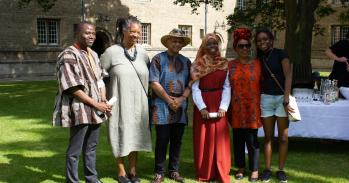
Justin Pearce (Department of Politics and International Studies) discusses the historical roots of the current conflict in Mozambique.
Justin Pearce (Department of Politics and International Studies) discusses the historical roots of the current conflict in Mozambique.
Peace in Mozambique lasted 20 years, between 1992 and 2012.
Following three years of skirmishes, conflict has escalated since 2015. The Mozambican Defence Force has been trying to destroy the military bases belonging to the Mozambican National Resistance (Renamo), the principal opposition to the ruling Mozambique Liberation Front (Frelimo) in parliament.
At least 10,000 people have fled Mozambique and sought refuge in Malawi, testifying to attacks perpetrated mostly by government soldiers. The conflict has served to consolidate local support for Renamo, which had previously fought the government from 1976 to 1992.
Pragmatic peace
The 1992 Rome Accord, which ended the 16-year war, was greeted at the time as a model of pragmatism. To overcome the misgivings of Renamo’s leader, Afonso Dhlakama, the accord allowed him to retain armed bodyguards.
Other Renamo soldiers were to have been integrated into the police. When this didn’t happen, they stayed loyal to Dhlakama. Renamo’s electoral support peaked in 1999 and then declined: the challenge of the opposition party trapped in a system where loyalty requires redistributing state largesse. Then-President Joaquim Chissano appeased Dhlakama only through diplomacy and patronage.

Things changed with the election of Armando Guebuza as president in 2004. Not only did Guebuza reject Chissano’s conciliatory attitude towards Dhlakama; his presidency also saw state capture by a section of the Frelimo elite at a time when Mozambique’s economy was being transformed by the coal and gas industries.
The emergence of a visibly wealthy elite while most people remained poor was a grievance that Renamo was later to exploit. In 2009, Dhlakama relocated to the northern city of Nampula where, in 2012, Renamo soldiers clashed with police at Renamo’s provincial headquarters. Dhlakama retreated to his wartime redoubt at Satungira in the Gorongosa National Park in Sofala province. Meanwhile, Renamo soldiers were quietly establishing bases in rural areas across the central provinces.
An army of ageing combatants
The next phase of the crisis began with a gathering of Renamo men in Muxúnguè, a town on the north-south arterial road through Sofala province. Residents of the town recalled that by the end of March 2013 several hundred were camped out at the local Renamo office and conducting marching drills.
The men were all at least 40 years old. A peculiar feature of this conflict has been Renamo’s reliance on ageing combatants from the civil war, rather than recruiting fresh blood. On April 3, police fired teargas to disperse the men. The next day, Renamo attacked the police station before retreating to an unknown location in the bush outside the town.
Later that year, Renamo began systematically to ambush vehicles on the national road south of Muxúnguè. Civilian casualties were few, but the threat to the economy alarmed the government. The defence force began counterinsurgency operations against farming communities that it suspected of supporting Renamo.

Negotiations got under way, mediated by Mozambican civil society, but with little apparent enthusiasm from either side. Renamo’s demands centred on three main points. First, it should have the right to appoint officers to the defence force equivalent to those appointed by the government. This was a provision of the Rome Accord, ignored in recent years as retired ex-Renamo officers were replaced by government (in effect, Frelimo) nominees.
Second, Renamo demanded measures to deal with electoral malpractice. Finally, Renamo wanted power to be devolved to the provinces; this would create a patronage base for Renamo – and for that reason would be hard for Frelimo to accept.
The negotiations resulted only in a truce to allow elections to go ahead as scheduled in October 2014. The results revealed a resurgence in support for Renamo and for Dhlakama.
Conflicting historical narratives
Interviews I did in Sofala during the lull that followed the 2014 election, as part of an ongoing research project, gave some clues as to why so many central Mozambicans regard an armed Renamo as a preferable alternative to the status quo.
When people talked about local history, they evoked divisions going back to the independence struggle in the 1960s. In contrast to Frelimo’s official history of undivided nationalism, people in Sofala recall a fractious alliance between leaders from different parts of Mozambique.
They remember a pastor from Sofala called Uria Simango, who as Frelimo vice-president was expected to succeed Eduardo Mondlane, who was killed in 1969. The fact that Simango was outmanoeuvred by Samora Machel, a southerner who led Mozambique to independence in 1975, is understood as part of a pattern of southern domination over the rest of Mozambique.
After independence, Frelimo’s attempts to relocate peasants to communal villages engendered support in Sofala for a Renamo that promised to reverse the collectivisation policy. When people speak of their own poverty today, they contrast it with wealth being amassed by the southern elite.
Frelimo’s crisis of legitimacy
When police demand bribes from farmers taking produce to market, people interpret this as symptomatic of a state that predates on central Mozambicans and has no legitimacy to rule. This suggests a reason why, when Renamo guerrillas reappeared in villages in recent years, they were welcomed by people who harboured long-held resentments.

Refugees from Mozambique’s Tete province whom I interviewed in Malawi this year also saw the state as a predatory force. But unlike people in Sofala, they had no historic allegiance to Renamo. When Renamo established bases in Tete in 2012 many were apprehensive, but warmed to Renamo’s men, who explained they had come to bring “democracy”.
Trouble began only after the 2014 elections. People initially believed Renamo had won, then were confused when they heard Frelimo’s candidate, Filipe Nyusi, had become president.
Refugees said they had expected Renamo to take power for two reasons, each based on a misunderstanding of democracy that Renamo had apparently encouraged. First, because Renamo had a majority in more than half of Mozambique’s provinces, it ought to run the country. Second, they insisted that “democracy means alternation of power”: the fact that Frelimo has been in power since 1975 was reason enough for a change.

Village ‘chiefs’ and ‘secretaries’
Renamo began during 2015 to assert its presence by appointing “chiefs” and “secretaries” in villages, in parallel with the Frelimo appointees who represent the state as well as the party. Not surprisingly, this alarmed the government, which in late 2015 began a new push to defeat Renamo.
Accounts from throughout central Mozambique reveal a consistent strategy. Government troops would try to expel Renamo, and then attack nearby civilians, accusing them of supporting Renamo. They burnt houses, sometimes with the occupants inside. They burnt grain stores, assuming these to be supplies for Renamo.
Some people were shot, others captured and interrogated. Women and men were raped. Renamo soldiers have been more restrained, targeting Frelimo officials. The Mozambican army is currently trying to take Renamo’s Satungira headquarters, but mountainous terrain gives the guerrillas an advantage.
What is happening in Mozambique is not exactly a popular uprising. It was ignited by Dhlakama’s desire for a share of political power, and its associated wealth, in a situation where the state is synonymous with Frelimo. The Rome Accord deserves some blame for centralising politics while allowing an opposition movement to retain access to the means of violence: 20 years later, Dhlakama realised his soldiers were the only asset he had left.
Nevertheless, the recent uprising could not have happened without popular support – support that Renamo mobilised by presenting ideas about history and democracy in a way that resonated with real grievances.
Justin Pearce, Leverhulme Early Career Fellow in Politics and International Studies & Research Associate of St John's College Cambridge, University of Cambridge
This article was originally published on The Conversation. Read the original article.
The opinions expressed in this article are those of the individual author(s) and do not represent the views of the University of Cambridge.
![]()

The text in this work is licensed under a Creative Commons Attribution 4.0 International License. For image use please see separate credits above.




